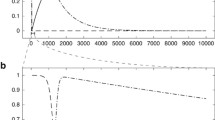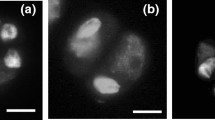Abstract
Although polyploids are common among plants and some animals, polyploidization often causes reproductive failure. Triploids, in particular, are characterized by the problems of chromosomal pairing and segregation during meiosis, which may cause aneuploid gametes and results in sterility. Thus, they are generally considered to reproduce only asexually. In the case of the Platyhelminthes Dugesia ryukyuensis, populations with triploid karyotypes are normally found in nature as both fissiparous and oviparous triploids. Fissiparous triploids can also be experimentally sexualized if they are fed sexual planarians, developing both gonads and other reproductive organs. Fully sexualized worms begin reproducing by copulation rather than fission. In this study, we examined the genotypes of the offspring obtained by breeding sexualized triploids and found that the offspring inherited genes from both parents, i.e., they reproduced truly bisexually. Furthermore, meiotic chromosome behavior in triploid sexualized planarians differed significantly between male and female germ lines, in that female germ line cells remained triploid until prophase I, whereas male germ line cells appeared to become diploid before entry into meiosis. Oocytes at the late diplotene stage contained not only paired bivalents but also unpaired univalents that were suggested to produce diploid eggs if they remained in subsequent processes. Triploid planarians may therefore form euploid gametes by different meiotic systems in female and male germ lines and thus are be able to reproduce sexually in contrast to many other triploid organisms.




Similar content being viewed by others
References
Alves MJ, Coelho MM, Collares-Pereira MJ (1998) Diversity in the reproductive modes of females of the Rutilus alburnoides complex (Teleostei, Cyprinidae): a way to avoid the genetic constraints of uniparentalism. Mol Biol Evol 15:1233–1242
Arai K, Mukaino M (1998) Electrophoretic analysis of the diploid progenies from triploid × diploid crosses in the loach Misgurnus anguillicaudatus (Pisces: Cobitidae). J Exp Zool 280:368–374
Benazzi M (1966) Considerations on the neoblasts of planarians on the basis of certain karyological evidence. Chromosoma 19(1):14–27
Christiansen DG (2009) Gamete types, sex determination and stable equilibria of all-hybrid populations of diploid and triploid edible frogs (Pelophylax esculentus). BMC Evol Biol 9:135. doi:10.1186/1471-2148-9-135
Cimino MC (1972) Egg-production, polyploidization and evolution in a diploid all-female fish of the genus Poeciliopsis. Evolution 26(2):294–306
Comai L (2005) The advantages and disadvantages of being polyploid. Nat Rev Genet 6(11):836–846. doi:10.1038/nrg1711
Cunado N, Terrones J, Sanchez L, Martinez P, Santos JL (2002) Sex-dependent synaptic behaviour in triploid turbot, Scophthalmus maximus (Pisces, Scophthalmidae). Heredity 89(6):460–464. doi:10.1038/sj.hdy.6800165
D’Souza TG, Storhas M, Schulenburg H, Beukeboom LW, Michiels NK (2004) Occasional sex in an ‘asexual’ polyploid hermaphrodite. Proc Biol Sci 271(1543):1001–1007. doi:10.1098/rspb.2004.2675
Gunther R, Uzzell T, Berger L (1979) Inheritance patterns in triploid Rana “esculenta” (Amphibia, Salientia). Mitt Zool Mus Berlin 55(1):35–57
Hoshi M, Kobayashi K, Arioka S, Hase S, Matsumoto M (2003) Switch from asexual to sexual reproduction in the planarian Dugesia ryukyuensis. Integr Comp Biol 43(2):242–246. doi:10.1093/icb/43.2.242
Jiao Y, Wickett NJ, Ayyampalayam S et al (2011) Ancestral polyploidy in seed plants and angiosperms. Nature 473(7345):97–100. doi:10.1038/nature09916
Kobayashi K, Hoshi M (2002) Switching from asexual to sexual reproduction in the planarian Dugesia ryukyuensis: change of the fissiparous capacity along with the sexualizing process. Zool Sci 19(6):661–666
Kobayashi K, Koyanagi R, Matsumoto M, Cabrera JP, Hoshi M (1999) Switching from asexual to sexual reproduction in the planarian Dugesia ryukyuensis: Bioassay system and basic description of sexualizing process. Zool Sci 16(2):291–298. doi:10.2108/zsj.16.291
Kobayashi K, Ishizu H, Arioka S, Cabrera JP, Hoshi M, Matsumoto M (2008) Production of diploid and triploid offspring by inbreeding of the triploid planarian Dugesia ryukyuensis. Chromosoma 117(3):289–296. doi:10.1007/s00412-008-0148-6
Kuraku S, Meyer A, Kuratani S (2009) Timing of genome duplications relative to the origin of the vertebrates: did cyclostomes diverge before or after? Mol Biol Evol 26(1):47–59. doi:10.1093/molbev/msn222
Lázaro EM, Sluys R, Pala M, Stocchino GA, Baguna J, Riutort M (2009) Molecular barcoding and phylogeography of sexual and asexual freshwater planarians of the genus Dugesia in the Western Mediterranean (Platyhelminthes, Tricladida, Dugesiidae). Mol Phylogenet Evol 52(3):835–845. doi:10.1016/j.ympev.2009.04.022
Morishima K, Yoshikawa H, Arai K (2008) Meiotic hybridogenesis in triploid Misgurnus loach derived from a clonal lineage. Heredity 100(6):581–586. doi:10.1038/hdy.2008.17
Nodono H, Ishino Y, Hoshi M, Matsumoto M (2012) Stem cells from innate sexual but not acquired sexual planarians have the capability to form a sexual individual. Mol Reprod Dev 79:757–766. doi:10.1002/mrd.22109
Otto SP, Whitton J (2000) Polyploid incidence and evolution. Ann Rev Genet 34:401–437. doi:10.1146/annurev.genet.34.1.401
Rasmussen SW (1977) Chromosome pairing in triploid females of Bombyx mori analyzed by three dimensional reconstructions of synaptonemal complexes. Carlsberg Res Commun 42:163–197
Tamura S, Oki I, Kawakatsu M (1995) A review of chromosomal variation in Dugesia japonica and D. ryukyuensis in the Far East. Hydrobiologia 305(1–3):79–84. doi:10.1007/bf00036366
Tunner HG, Heppich S (1981) Premeiotic genome exclusion during oogenesis in the common edible frog, Rana esculenta. Die Naturwissenschaften 68(4):207–208
Tunner HG, Heppich-Tunner S (1991) Genome exclusion and 2 strategies of chromosome duplication in oogenesis of a hybrid frog. Die Naturwissenschaften 78(1):32–34. doi:10.1007/bf01134041
Van de Peer Y, Maere S, Meyer A (2009) The evolutionary significance of ancient genome duplications. Nat Rev Genet 10(10):725–732. doi:10.1038/nrg2600
Vincent JE, Jones GH (1993) Meiosis in autopolyploid Crepis capillaris. I. Triploids and trisomics; implications for models of chromosome pairing. Chromosoma 102(3):195–206. doi:10.1007/bf00387734
Zhang QQ, Arai K, Yamashita M (1998) Cytogenetic mechanisms for triploid and haploid egg formation in the triploid loach Misgurnus anguillicaudatus. J Exp Zool 281(6):608–619. doi:10.1002/(sici)1097-010x(19980815)281:6<608::aid-jez9>3.0.co;2-r
Acknowledgments
We thank Dr. Marina Dan, Dr. Motonori Hoshi, and Dr. Gary Wessel for critically reading the manuscript. This work was supported by Grant-in-Aid for Challenging Exploratory Research from the Ministry of Education, Culture, Sports, Science and Technology, Japan to M.M. (No. 23657008) and Grant-in-Aid for JSPS Fellows to A.C. (No. 25-5247) from Japan Society for the Promotion of Science.
Author information
Authors and Affiliations
Corresponding author
Electronic supplementary material
Below is the link to the electronic supplementary material.
ESM 1
(PDF 1485 kb)
Supplementary Table
(PDF 9 kb)
Rights and permissions
About this article
Cite this article
Chinone, A., Nodono, H. & Matsumoto, M. Triploid planarian reproduces truly bisexually with euploid gametes produced through a different meiotic system between sex. Chromosoma 123, 265–272 (2014). https://doi.org/10.1007/s00412-013-0449-2
Received:
Revised:
Accepted:
Published:
Issue Date:
DOI: https://doi.org/10.1007/s00412-013-0449-2




